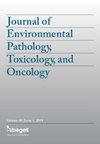Molecular mechanism of lncRNAs in ovarian cancer: lncRNA CASC19 regulates the malignant progression of ovarian cancer through miR-761/CBX2 axis
IF 2.9
4区 医学
Q3 TOXICOLOGY
Journal of Environmental Pathology Toxicology and Oncology
Pub Date : 2024-08-01
DOI:10.1615/jenvironpatholtoxicoloncol.2024053797
引用次数: 0
Abstract
Background: Long non-coding RNAs (lncRNAs) are involved in the numerous types of tumors. The aim of this study is to comprehend the pathological mechanism of lncRNA CASC19 in ovarian cancer. Methods: CASC19, miR-761 and CBX2 expression in the samples was quantitatively detected by real-time quantitative polymerase chain reaction (RT-qPCR) reaction. The proliferation and apoptosis levels of ovarian cancer cells were evaluated via cell counting kit-8 (CCK-8) and Flow cytometry assays. The targeting relationship and correlation of CASC19, miR-761 and CBX2 were investigated through luciferase reporter assay and Pearson assay. Results: CASC19 and CBX2 were enriched in ovarian cancer, while miR-761 expression was decreased. Silencing CASC19 suppressed the cell growth and promoted cell apoptosis. CASC19 targeted the inhibition of miR-761 expression and regulated the level of CBX2. In addition, the miR-761 inhibitor reversed the inhibitory effect of si-CASC19 on the biological activity of ovarian cancer cells, while si-CBX2 restored the regulation of miR-761 inhibitor on the development of ovarian cancer. Conclusion: LncRNA CASC19 mediated the malignant progression of ovarian cancer through miR-761/CBX2 axis, which provided a potential therapeutic target for the cure of patients.lncRNA在卵巢癌中的分子机制:lncRNA CASC19通过miR-761/CBX2轴调控卵巢癌的恶性进展
背景:长非编码RNA(lncRNA)与多种肿瘤有关。本研究旨在了解lncRNA CASC19在卵巢癌中的病理机制:方法:采用实时定量聚合酶链式反应(RT-qPCR)定量检测样本中CASC19、miR-761和CBX2的表达。通过细胞计数试剂盒-8(CCK-8)和流式细胞术检测卵巢癌细胞的增殖和凋亡水平。通过荧光素酶报告实验和皮尔逊实验研究了CASC19、miR-761和CBX2的靶向关系和相关性:结果:CASC19和CBX2在卵巢癌中富集,而miR-761表达下降。沉默CASC19可抑制细胞生长,促进细胞凋亡。CASC19靶向抑制了miR-761的表达,并调节了CBX2的水平。此外,miR-761抑制剂逆转了si-CASC19对卵巢癌细胞生物活性的抑制作用,而si-CBX2则恢复了miR-761抑制剂对卵巢癌发展的调控作用:结论:LncRNA CASC19通过miR-761/CBX2轴介导卵巢癌的恶性进展,为治愈患者提供了潜在的治疗靶点。
本文章由计算机程序翻译,如有差异,请以英文原文为准。
求助全文
约1分钟内获得全文
求助全文
来源期刊
CiteScore
3.80
自引率
0.00%
发文量
20
审稿时长
>12 weeks
期刊介绍:
The Journal of Environmental Pathology, Toxicology and Oncology publishes original research and reviews of factors and conditions that affect human and animal carcinogensis. Scientists in various fields of biological research, such as toxicologists, chemists, immunologists, pharmacologists, oncologists, pneumologists, and industrial technologists, will find this journal useful in their research on the interface between the environment, humans, and animals.

 求助内容:
求助内容: 应助结果提醒方式:
应助结果提醒方式:


